The Properties of Modified Bagasse Fiber/Nano-TiO2 Composite Asphalt in a High-Temperature and High-Humidity Salt Environment
Abstract
:1. Introduction
2. Materials
2.1. Base Asphalt and Mineral Powder
2.2. Bagasse
2.3. Salt Solutions
2.4. Nano-Material
2.5. Silane Coupling Agent
2.6. Sample Preparation
2.6.1. Preparation of Modified Bagasse Fiber
2.6.2. Preparation of Modified Bagasse Fiber–TiO2 Asphalt Binder
3. Experimental Methods
3.1. Modified Bagasse Stability Test
3.2. Aging Test
3.3. Wetting–Drying Cycle Test under Salt Corrosion Conditions
3.4. Rotational Viscosity Test
3.5. Dynamic Shear Rheometer Test (JTG E20-2011, T0602)
3.6. Multiple Stress Creep and Recovery Test (MSCR)
3.7. Linear Amplitude Sweep Test (LAS)
3.8. Four-Point Bending Fatigue Test
4. Results and Discussion
4.1. Effects of NaOH/Silane Coupling Agent on Bagasse Fiber Modification
4.1.1. High-Temperature Oil Absorption
4.1.2. Heat Stability
4.1.3. Hygroscopicity
4.1.4. Surface Microscopic Analysis before and after Modification
4.2. Analysis of Conventional Physical Properties and Storage Properties of Asphalt Binders in Different Erosion Environments
4.2.1. General Physical Properties
4.2.2. Storage Performance
4.3. Rheological Property Analysis of Bitumen with Different Bagasse Fiber Contents in a High-Temperature and High-Humidity Salt Environment
4.3.1. Rotational Viscosity
4.3.2. Dynamic Shear Rheological Test
- Under the same erosion environment and test temperature, the complex shear modulus (G*) and rutting factor (G*/sin δ) of Bn-570-0.5 are the largest, and the phase angle δ is the smallest. The results show that the increase in modified bagasse fiber content is positively correlated with the improvement in asphalt deformation resistance under the same external conditions.
- Under the same fiber content and test temperature, Na2SO4 has the greatest inhibition on the complex shear modulus (G*) of asphalt. Taking Bn-570-0.5 in Figure 11 as an example, the values of G* in pure water, NaCl, and Na2SO4 are 278.3 kPa, 182.4 kPa, and 138 kPa at 40 °C; 241.5 kPa, 140.9 kPa, and 104.2 kPa at 52 °C; and 221.8 kPa, 123.5 kPa, and 102.3 kPa at 56 °C. In addition, when the temperatures are 40 °C, 52 °C, and 56 °C, the absolute values of the difference between the complex shear modulus of Bn-570-0.5 eroded by NaCl and Na2SO4 are 44.4, 36.7, and 21.2, respectively, indicating that the difference between the complex shear modulus (G*) in NaCl and Na2SO4 gradually shrinks with the increase in temperature. That is, the increase in temperature weakens the difference in the erosion effect of different types of salt erosion on the asphalt binder.
- When the erosion environment is the same but the temperature is different, there are two trends in phase angle change. One is that the phase angle increases with the increase in temperature, as shown in Figure 12. B, Bn-570-0.2, and Bn-570-0.3 indicate that the effect of a low fiber content on inhibiting the “asphalt flow” is not obvious, and the asphalt mortar gradually changes from a solid to a fluid, similar to a Newtonian fluid, with the increase in temperature. The other trend is that there is a stage of “basically unchanged or slowly decreasing” after the phase angle reaches the peak with the increase in temperature, such as Bn-570-0.4 and Bn-570-0.5 in Figure 12, which indicate that the distribution of fibers in the asphalt is sufficient. The bridge effect is used to increase the friction between asphalt molecules and, to some extent, to restrain the flow deformation of asphalt under high-temperature shear force. The above trends in phase angle change are similar to the study of Cui et al. (2022) [45] (that is, the phase angle of base asphalt increases with increasing temperature, while that of fiber-asphalt increases first and then slightly decreases), but the peak temperature of the asphalt phase angle is 10 °C higher than modified bagasse fiber asphalt (56 °C), which may be related to asphalt materials with stronger adhesion being selected.
- However, if the temperature continues to rise, the phase angle will return to an increasing state after a short decrease, the fiber function will be sharply weakened, and the overall deformation resistance of the asphalt will also decline rapidly (Figure 13). The complex shear modulus (G*) and rutting factor (G*/sin δ) will eventually approach 0.
4.3.3. Analysis of MSCR Test Results
4.3.4. Analysis of Linear Amplitude Scanning Test (LAS) Results
4.3.5. Four-Point Bending Fatigue Life Analysis of Modified Bagasse Fiber Asphalt Mixture
4.4. Analysis of the Erosion Mechanism of Modified Bagasse Fiber Asphalt Binder and Mixture in a High-Temperature and High-Humidity Salt Environment
4.4.1. Analysis of the Aging Mechanism of Pure Water on Asphalt Binder and Asphalt Mixture
4.4.2. Analysis of the Erosion Mechanism of Salt Solution on Asphalt Binder and Mixture
4.4.3. Analysis of the Durability Mechanism of Modified Bagasse Fiber/Nano-TiO2 to Enhance Asphalt Binder and Mixture in a High-Temperature and High-Humidity Salt Environment
5. Conclusions
- Compared with the sole use of NaOH, a NaOH/silane coupling agent can more effectively remove the surface impurities of the original bagasse fiber, increase the specific surface area of the fiber and asphalt, and improve the stability of fiber and asphalt bonding. However, there is little difference in the improvement in the moisture absorption performance of bagasse fiber with different types of silane coupling agent.
- Compared with the silane coupling agents KH550 and KH590, bagasse fiber modified with NaOH combined with KH570 showed better high-temperature oil absorption and heat stability, as well as greater compatibility with base asphalt.
- The Na2SO4 solution provides the worst erosion environment, and the order of erosion capacity is Na2SO4 > NaCl > pure water. The increase in test temperature and modified fiber content can weaken the sensitivity of asphalt binder to different erosion environments.
- When the fiber content is less than 0.2%, a uniform and overlapping mesh structure cannot be formed in the asphalt binder, and the improvement effect is not obvious. When the fiber content is greater than 0.5%, the clumping rate will increase, and the clumped fiber will form a weak layer inside the asphalt mixture specimen, weakening the “reinforcement” and “bridging” roles.
- The 0.5% modified bagasse fiber/nano-TiO2 asphalt binder and the mixture have the best effect in a high-temperature and high-humidity salt environment. In the worst erosion environment, the penetration, softening point, creep recovery rate R3.2, non-recoverable creep compliance Jnr3.2, and PAV(5% strain)-fatigue life of Bn-570-0.5 were increased by −16.9%, 37.5%, 37.95%, −27.86%, and 38.30%, respectively, compared with the base asphalt binder (B). In addition, the four-point flexural fatigue life of the Bn-570-0.5 was 169.2% higher than that of the ordinary mixture without fiber.
Author Contributions
Funding
Institutional Review Board Statement
Informed Consent Statement
Data Availability Statement
Acknowledgments
Conflicts of Interest
References
- Tsai, B.; Monismith, C.L. Influence of Asphalt Binder Properties on the Fatigue Performance of Asphalt Concrete Pavements (With Discussion). J. Assoc. Asph. Paving Technol. 2005, 74, 733–790. [Google Scholar]
- Feng-Xian, W. The disease analysis and preventing of asphalt pavement crack, Shanxi Architecture. Shanxi Archit. 2008, 34, 300–301. [Google Scholar]
- Nhat, T.T.; Takahashi, O. Investigation on indices of workability and ruttingresistance for wearing course mixtures. Balt. J. Road. Bridge. Eng. 2017, 12, 30–37. [Google Scholar] [CrossRef]
- Buttlar, W.G.; Hill, B.C.; Wang, H.; Mogawer, W.S. Performance space diagram for the evaluation of high- and low-temperature asphalt mixture performance. Road Mater. Pavement Des. 2017, 18, 336–358. [Google Scholar]
- Gorkem, C.; Sengoz, B. Predicting stripping and moisture induced damage of asphalt concrete prepared with polymer modified bitumen and hydrated lime. Constr. Build. Mater. 2009, 23, 2227–2236. [Google Scholar]
- Feng, B.; Wang, H.; Li, S.; Ji, K.; Li, L.; Xiong, R. The durability of asphalt mixture with the action of salt erosion: A review. Constr. Build. Mater. 2021, 17, e01706. [Google Scholar]
- Sun, B.; Chen, F.; Yang, W.; Shen, H.; Xie, D. Effects of nano-TiO2 and normal size TiO2 additions on the microstructure and magnetic properties of manganese–zinc power ferrites. J. Magn. Magn. Mater. 2014, 349, 180–187. [Google Scholar]
- Shafabakhsh, G.; Mirabdolazimi, S.M.; Sadeghnejad, M. Evaluation the effect of nano-TiO2 on the rutting and fatigue behavior of asphalt mixtures. Constr. Build. Mater. 2014, 54, 566–571. [Google Scholar]
- Azarhoosh, A.; Nejad, F.M.; Khodaii, A. Evaluation of the effect of nano-TiO2 on the adhesion between aggregate and asphalt binder in hot mix asphalt. Eur. J. Environ. Civ. Eng. 2017, 22, 946–961. [Google Scholar]
- Daroonparvar, M.; Yajid, M.A.M.; Rad, H.R.B.; Yusof, N.M.; Izman, S.; Hamzah, E.; Kadir, M.R.A. Corrosion resistance investigation of nanostructured Si- and Si/TiO2-coated Mg alloy in 3.5% NaCl solution. Vacuum 2014, 108, 61–65. [Google Scholar]
- Liao, M.; Liu, Z.H.; Gao, Y.; Liu, L.H.; Xiang, S. Study on UV aging resistance of nano-TiO2/montmorillonite/styrene-butadiene rubber composite modified asphalt based on rheological and microscopic properties. Constr. Build. Mater. 2021, 301, 124108. [Google Scholar]
- Gong, Y.; Song, J.; Bi, H.; Tian, Z. Optimization Design of the Mix Ratio of a Nano-TiO2/CaCO3-Basalt Fiber Composite Modified Asphalt Mixture Based on Response Surface Methodology. Appl. Sci. 2020, 10, 4596. [Google Scholar] [CrossRef]
- Abtahi, S.M.; Sheikhzadeh, M.; Hejazi, S.M. Fiber-reinforced asphalt-concrete—A review. Constr. Build. Mater. 2010, 24, 871–877. [Google Scholar]
- Bayat, R.; Talatahari, S. Influence of Polypropylene Length on Stability and Flow of Fiber-reinforced Asphalt Mixtures. Civ. Eng. J. 2016, 2, 538–545. [Google Scholar] [CrossRef]
- Guo, Q.; Li, L.; Cheng, Y.; Jiao, Y.; Xu, C. Laboratory evaluation on performance of diatomite and glass fiber compound modified asphalt mixture. Mater. Des. 2015, 66, 51–59. [Google Scholar] [CrossRef]
- Liu, Z.H.; Chen, C.Y.; Qin, R.; Zou, X.T. Research to Performance of Basalt Fibre Strengthen SBS Modified Asphalt Mixture. Adv. Mater. Res. 2012, 446–449, 191–195. [Google Scholar]
- Zhang, S.Z. Rheological Behavior Study under High Temperature of Modified Asphalt with Lignin Fibre and Kieselguhr. J. Gansu Sci. 2019, 4, 56–60. [Google Scholar]
- Yao, H.; You, Z.; Li, L.; Goh, S.W.; Lee, C.H.; Yap, Y.K.; Shi, X. Rheological properties and chemical analysis of nanoclay and carbon microfiber modified asphalt with Fourier transform infrared spectroscopy. Constr. Build. Mater. 2013, 38, 327–337. [Google Scholar] [CrossRef]
- Li, Z.; Li, K.; Chen, W.; Liu, W.; Yin, Y.P.; Cong, P. Investigation on the Characteristics and Effect of Plant Fibers on the Properties of Asphalt Binders. SSRN Electron. J. 2022, 338, 127652. [Google Scholar] [CrossRef]
- Costa, L.F.D.; Lucena, L.C.D.F.; Lucena, A.E.D.F.; Barros, A.G.D. Use of Banana Fibers in SMA Mixtures. J. Mater. Civ. Eng. 2020, 32, 4019341. [Google Scholar] [CrossRef]
- Cavalcante, R.L.; Fernandes, J.L., Jr.; Marques, J.R.F.; Suarez, A. SMA Asphalt Mix Produced with the Addition of Fiber of Bagasse Sugarcane; Universidade Anhanguera-Uniderp: Campo Grande, Brazil, 2016. [Google Scholar]
- Li, Z.; Xuelei, Z.; Fa, C.; Zhang, Y.; Jianping, X.; Chen, H. Investigation on characteristics and properties of bagasse fibers: Performances of asphalt mixtures with bagasse fibers. Constr. Build. Mater. 2020, 248, 118648. [Google Scholar] [CrossRef]
- Umer, K.; Geremew, A.; Jemal, A. The comparative study on the performance of bamboo fiber and sugarcane bagasse fiber as modifiers in asphalt concrete production. Heliyon 2022, 8, e09842. [Google Scholar] [CrossRef]
- Mansor, S.; Zainuddin, N.I.; Aziz, N.A.; Razali, M.; Joohari, M.I. Sugarcane bagasse fiber—An eco-friendly pavement of SMA. In Proceedings of the Advances in Civil Engineering and Science Technology, Penang, Malaysia, 5–6 September 2018. [Google Scholar]
- He, Z.; Tan, F.; Huang, Q. Experimental study of bagasse fibre SMA asphalt mixture structural parameters. New Build. Mater. 2011, 38. Available online: https://kns.cnki.net/kcms2/article/abstract?v=3uoqIhG8C44YLTlOAiTRKgchrJ08w1e7tvjWANqNvp97ehCgz4HisaNR-TN9o4E--0tFYiaEUvhdyeslcsABAUE1Zk1pLBRH&uniplatform=NZKPT (accessed on 10 August 2023).
- Li, Z.; Li, M.; Liu, W.; Pang, X.; Tang, H.; Zhang, X.; Ma, C. Study on surface modification of bagasse fibers and road performances of asphalt mixture. J. Jilin Univ. 2022. Available online: https://www.cnki.net/kcms/doi/10.13229/j.cnki.jdxbgxb20220870.html (accessed on 10 August 2023).
- Li, J.; Yang, L.; He, L.; Guo, R.; Li, X.; Chen, Y.; Yassen, M.; Liu, Y. Station, CATAS, Research Progress in Comprehensive Utilization of Bagasse in China. Chin. J. Trop. Agric. 2017, 3, 35–70. [Google Scholar]
- JTG D50-2017; Specifications for Design of Highway Asphalt Pavement. Ministry of Transport of the People’s Republic of China: Beijing, China, 2017.
- JTG F40-2004; Technical Specififications for Construction of Highway Asphalt Pavements. Ministry of Transport of the People’s Republic of China: Beijing, China, 2004.
- JT/T 533-2004; Plant Fifibers Used in Asphalt Pavements. Ministry of Transport of the People’s Republic of China: Beijing, China, 2004.
- Zhou, Z.; Li, H.; Liu, X.; He, W. Investigation of sea salt erosion effect on the asphalt-aggregate interfacial system. Int. J. Pavement Res. Technol. 2020, 13, 145–153. [Google Scholar] [CrossRef]
- Chen, Y.; Tang, L.; Ye, Y.; Cheng, Z.; Zhou, Z. Effects of different chloride salts on granite residual soil: Properties and water–soil chemical interaction mechanisms. J. Soils Sediments. 2023, 23, 1844–1856. [Google Scholar] [CrossRef]
- Xiong, R.; Ci, C.; Ning, Q.; Lu, W.; Fa, Y.; Sheng, Y.; Guan, B.; Niu, D.; Geng, J.; Chen, H. Performance evaluation of asphalt mixture exposed to dynamic water and chlorine salt erosion. Constr. Build. Mater. 2019, 201, 121–126. [Google Scholar] [CrossRef]
- Cao, R. Experimental research on the effect of sulfate erosion on rubber asphalt mixture road performance. Highw. Transp. Inn. Mong. 2015, 4. Available online: https://www.cnki.com.cn/Article/CJFDTOTAL-NMGY201504006.htm (accessed on 10 August 2023).
- Sabzi, M.; Mirabedini, S.M.; Zohuriaan-Mehr, J.; Atai, M. Surface modification of TiO2 nano-particles with silane coupling agent and investigation of its effect on the properties of polyurethane composite coating. Prog. Org. Coat. 2009, 65, 222–228. [Google Scholar] [CrossRef]
- Ferrotti, G.; Baaj, H.; Besamusca, J.; Bocci, M.; Falchetto, A.C.; Grenfell, J.R.A.; Hofko, B.; Porot, L.; Poulikakos, L.D.; You, Z. Comparison of short term laboratory ageing on virgin and recovered binder from HMA/WMA mixtures. In Proceedings of the RILEM 252-CMB Symposium on Chemo-Mechanical Characterization of Bituminous Materials, Braunschweig, Germany, 17–18 September 2018; Rilem Bookseries. Springer: Cham, Switzerland, 2019. [Google Scholar]
- JTG E20-2011; Standard Test Methods of Bitumen and Bitumunous Mixtures for Highway Engineering. Ministry of Transport of the People’s Republic of China: Beijing, China, 2014.
- Shafabakhsh, G.; Ani, O.J. Experimental investigation of effect of Nano TiO2/SiO2 modified bitumen on the rutting and fatigue performance of asphalt mixtures containing steel slag aggregates. Constr. Build. Mater. 2015, 98, 692–702. [Google Scholar] [CrossRef]
- Rodrigues, J.A.; Pinheiro, G.D.S.; Vasconcelos, K.L.; Bernucci, L.L.B.; Romano, R.; Pileggi, R.G. DSR geometry impact on asphalt binder linear viscoelastic properties. In Advances in Materials and Pavement Performance Prediction II; CRC Press: London, UK, 2020. [Google Scholar]
- Zhang, J.; Walubita, L.F.; Faruk, A.N.M.; Karki, P.; Simate, G.S. Use of the MSCR test to characterize the asphalt binder properties relative to HMA rutting performance—A laboratory study. Constr. Build. Mater. 2015, 94, 218–227. [Google Scholar] [CrossRef]
- Hossain, Z.; Ghosh, D.; Zaman, M.; Hobson, K.R. Use of the Multiple Stress Creep Recovery (MSCR) Test Method to Characterize Polymer-Modified Asphalt Binders. J. Test. Eval. 2016, 44, 20140061. [Google Scholar] [CrossRef]
- Sabouri, M.; Mirzaiyan, D.; Moniri, A. Effectiveness of Linear Amplitude Sweep (LAS) asphalt binder test in predicting asphalt mixtures fatigue performance. Constr. Build. Mater. 2018, 171, 281–290. [Google Scholar] [CrossRef]
- AASHTO T 321; Standard Method of Test for Determining the Fatigue Life of Compacted Asphalt Mixtures Subjected to Repeated Flexural Bending. American Association of StateHighway and Transportation Officials: Washington, DC, USA, 2007.
- Shafabakhsh, G.; Rajabi, M.; Sahaf, A. The fatigue behavior of SBS/nanosilica composite modified asphalt binder and mixture. Constr. Build. Mater. 2019, 229, 116796. [Google Scholar] [CrossRef]
- Cui, S.; Sheng, Y.; Wang, Z.; Jia, H.; Qiu, W.; Temitope, A.A.; Xu, Z. Effect of the fiber surface treatment on the mechanical performance of bamboo fiber modified asphalt binder. Constr. Build. Mater. 2022, 347, 128453. [Google Scholar] [CrossRef]
- Delgado, H.A.; Arnaud, L. Investigation of the fatigue properties of asphalt mixtures reinforced with natural fibers. In Proceedings of the 5th International Conference Bituminous Mixtures and Pavements, Thessaloniki, Greece, 1–3 June 2011. [Google Scholar]
- Chen, S.; Xu, H.; He, X.; Su, Y.; Zhang, B.; Liu, Q. Oil-Grinded Recycled Kapok Fiber as a Bio-Packing for Eco-Friendly Modified Asphalt and its Aging Resistance Behavior. Constr. Build. Mater. 2022, 320, 126293. [Google Scholar] [CrossRef]
- Fang, C.; Zhang, Y.; Yu, Q.; Zhou, X.; Guo, D.; Yu, R.; Zhang, M. Preparation, Characterization and Hot Storage Stability of Asphalt Modified by Waste Polyethylene Packaging. J. Mater. Sci. Technol. 2013, 29, 434–438. [Google Scholar] [CrossRef]
- Kou, C.; Chen, Z.; Kang, A.; Zhang, M.; Wang, R. Rheological behaviors of asphalt binders reinforced by various fibers. Constr. Build. Mater. 2022, 323, 126626. [Google Scholar] [CrossRef]
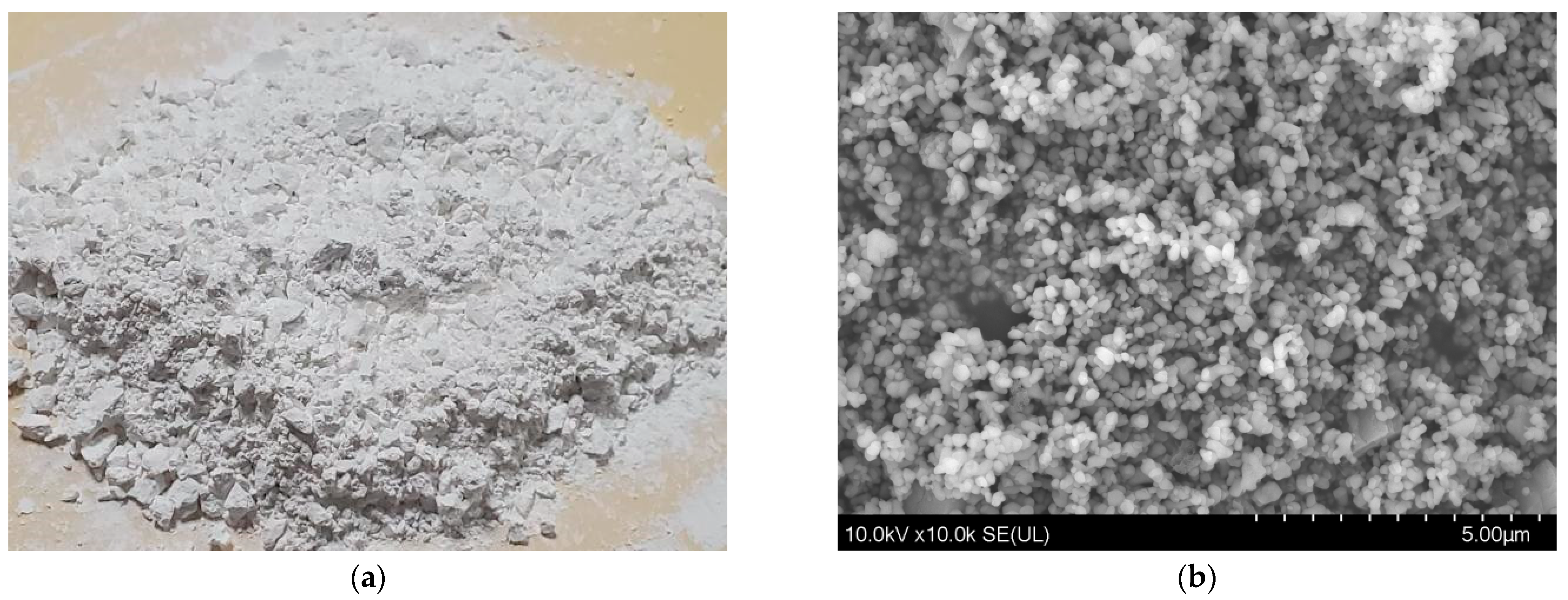
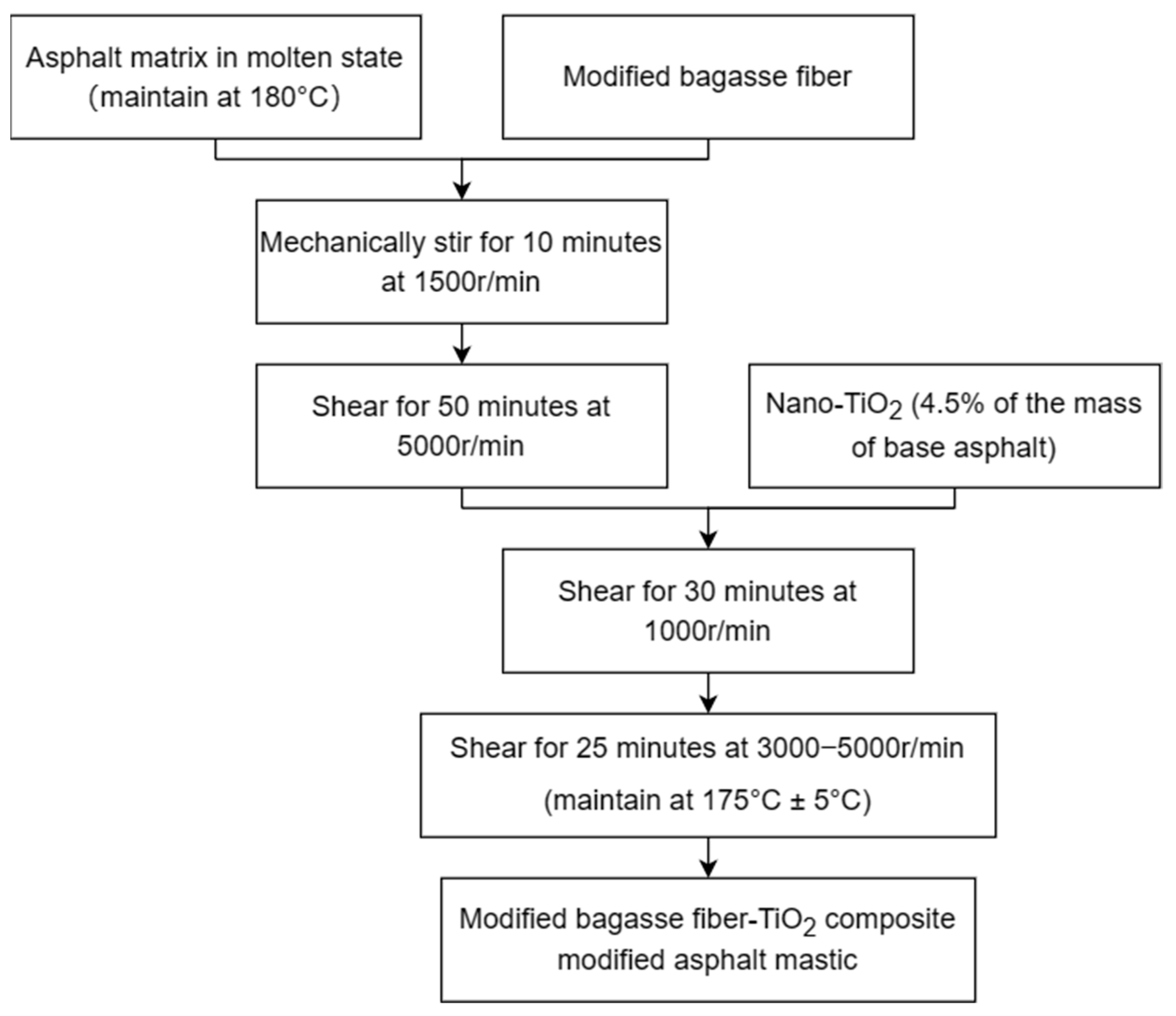
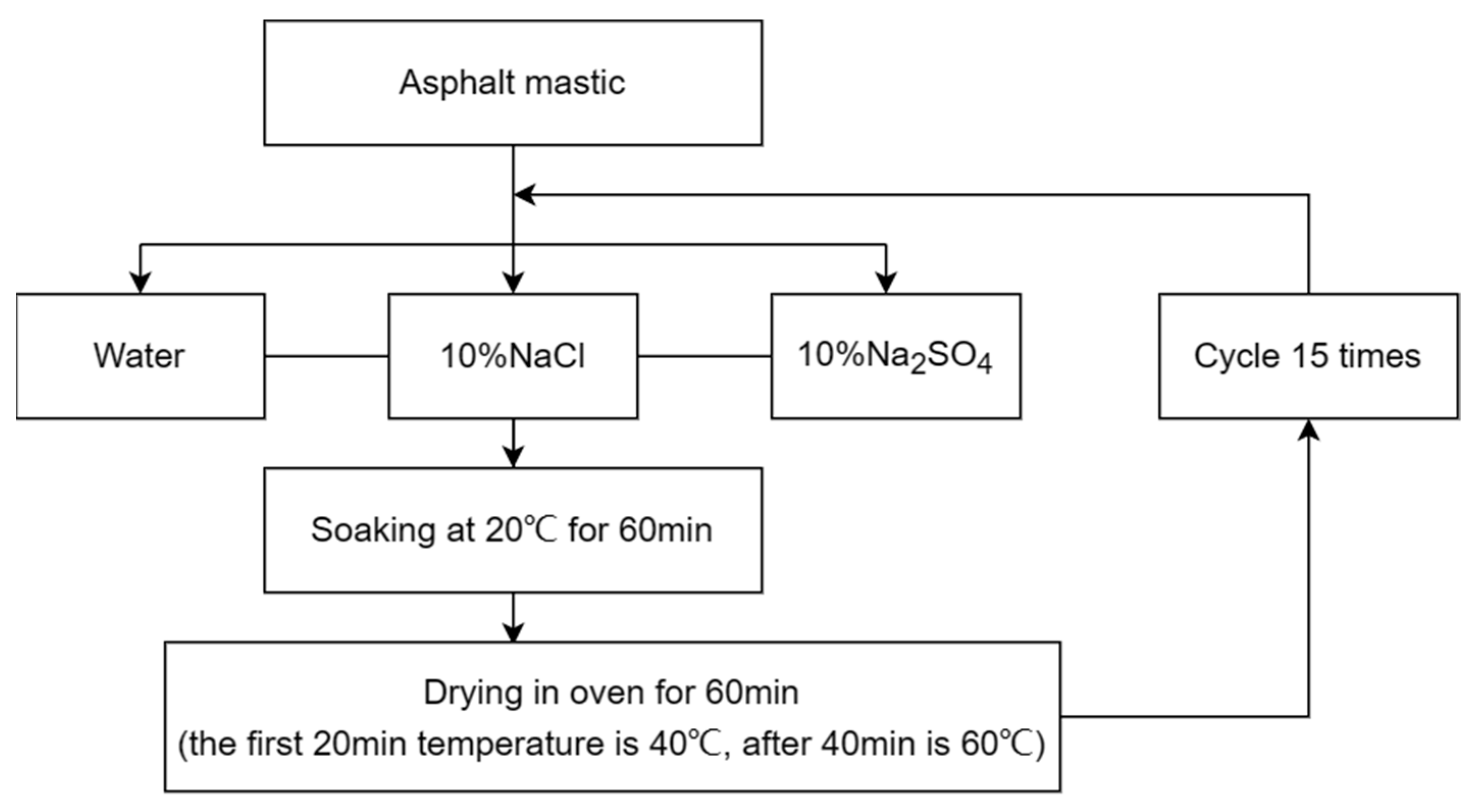

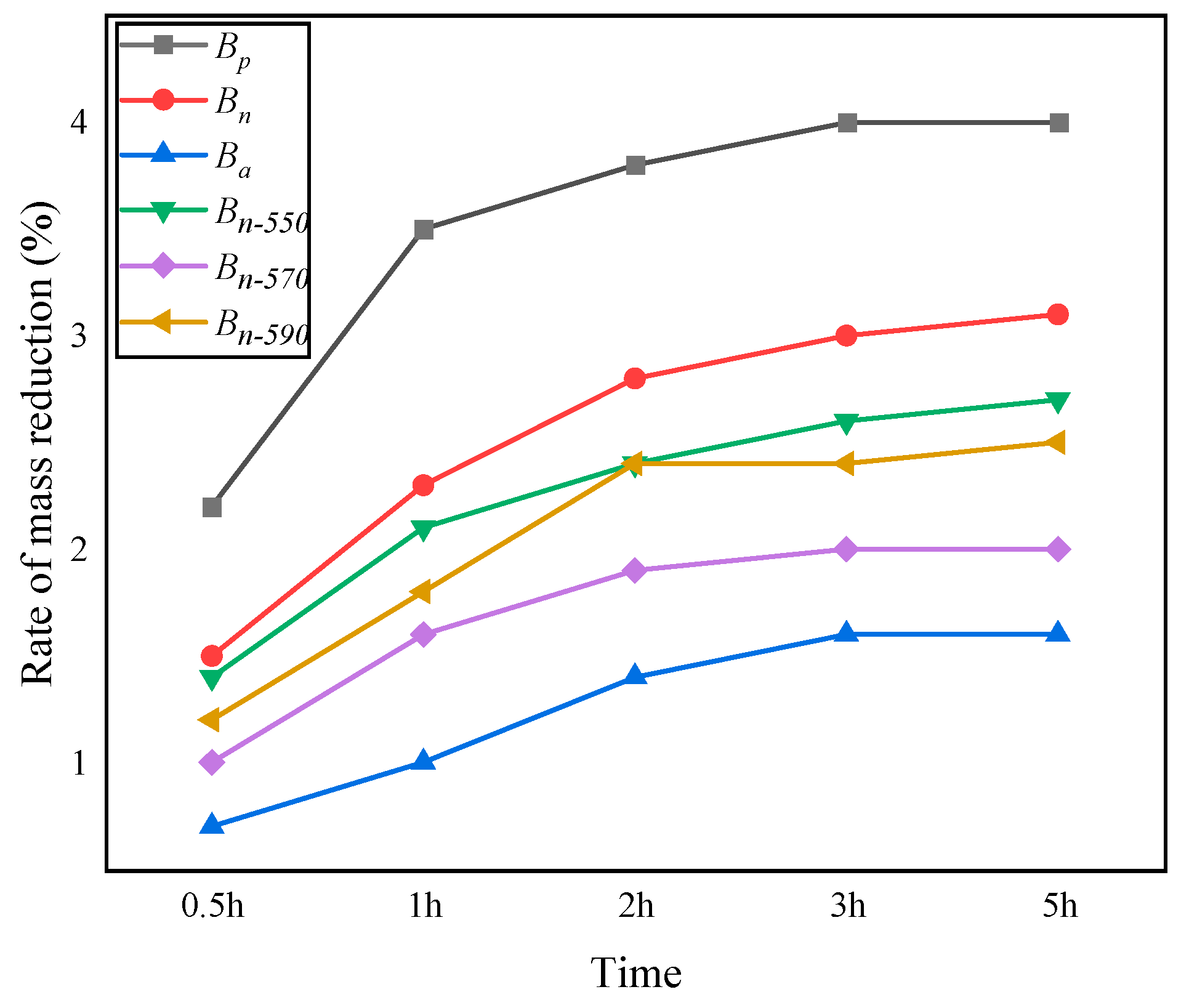
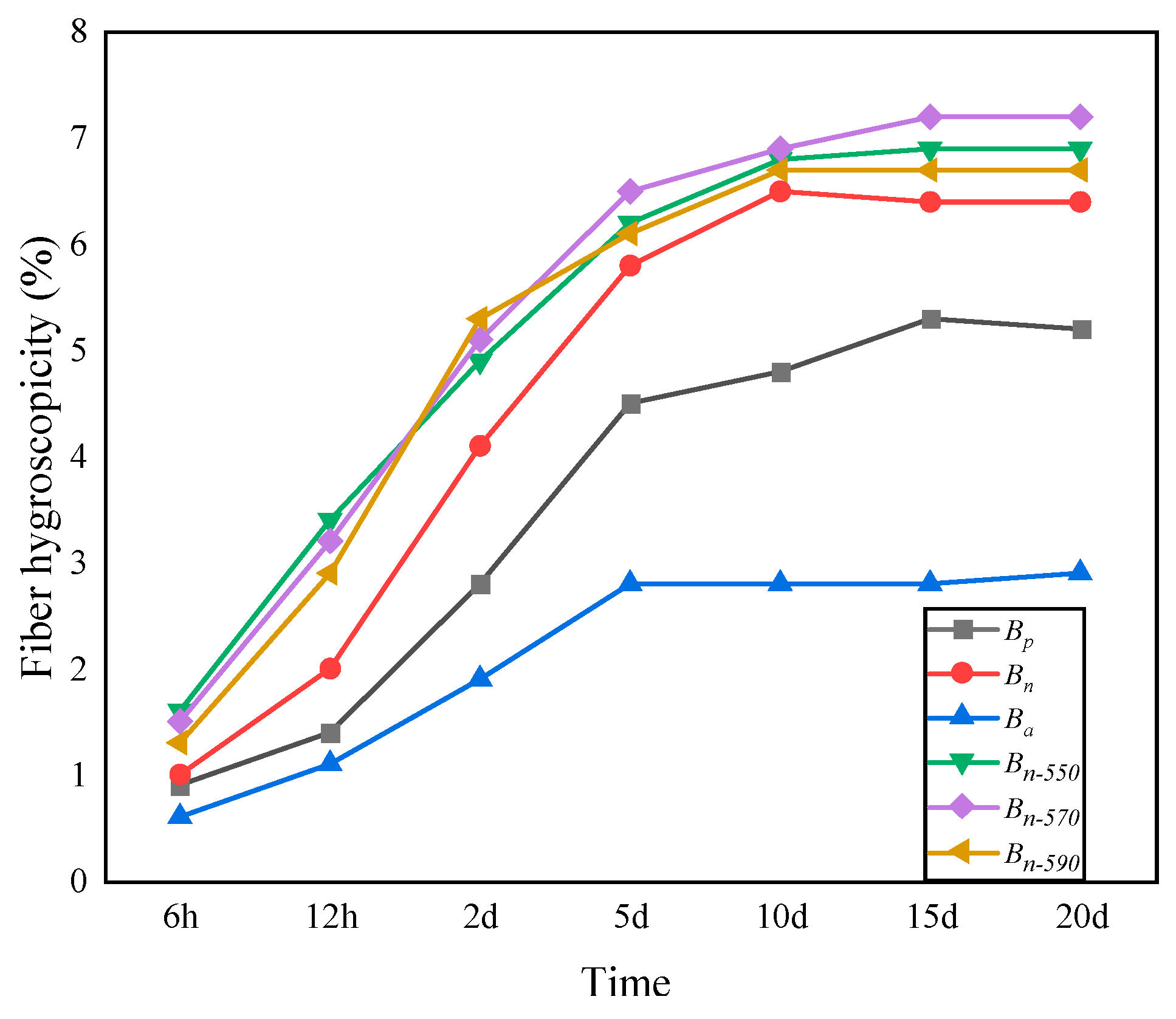
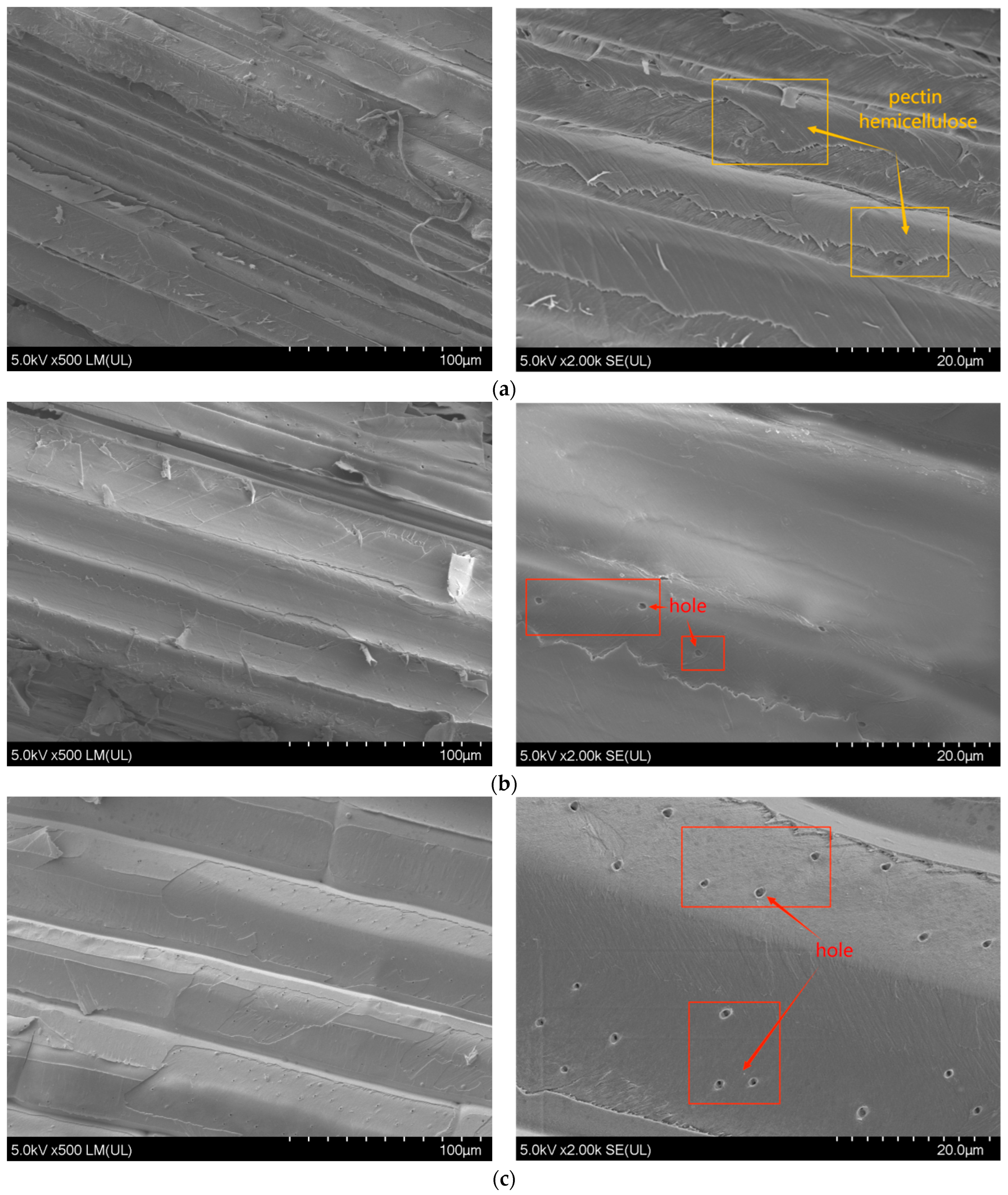
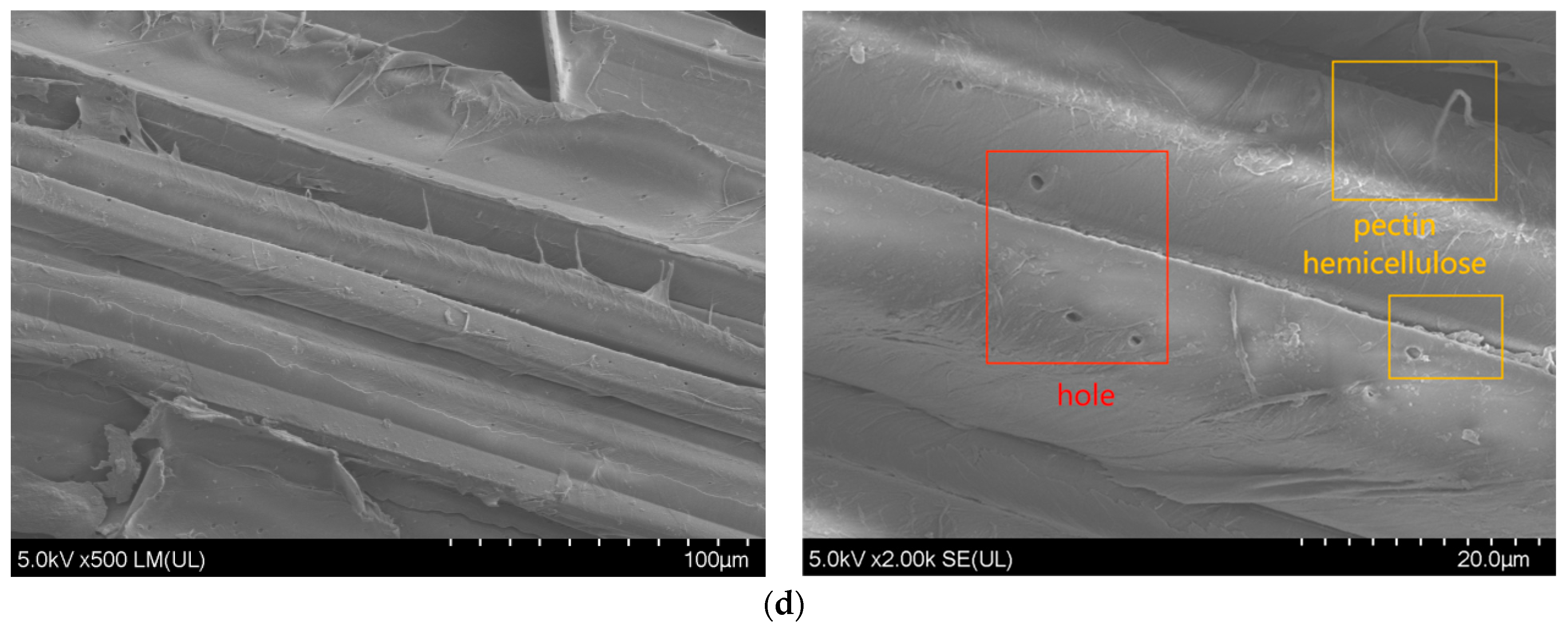
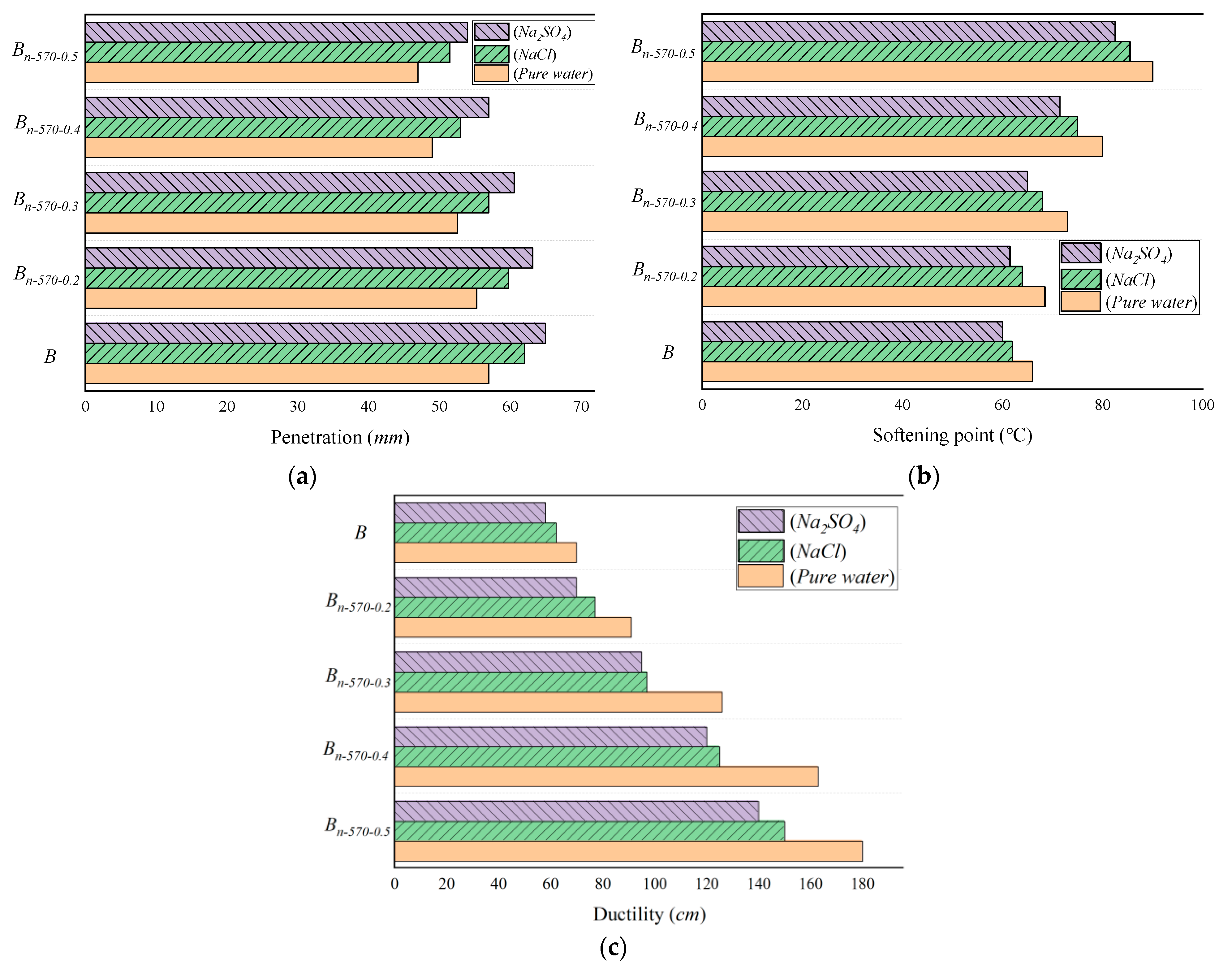


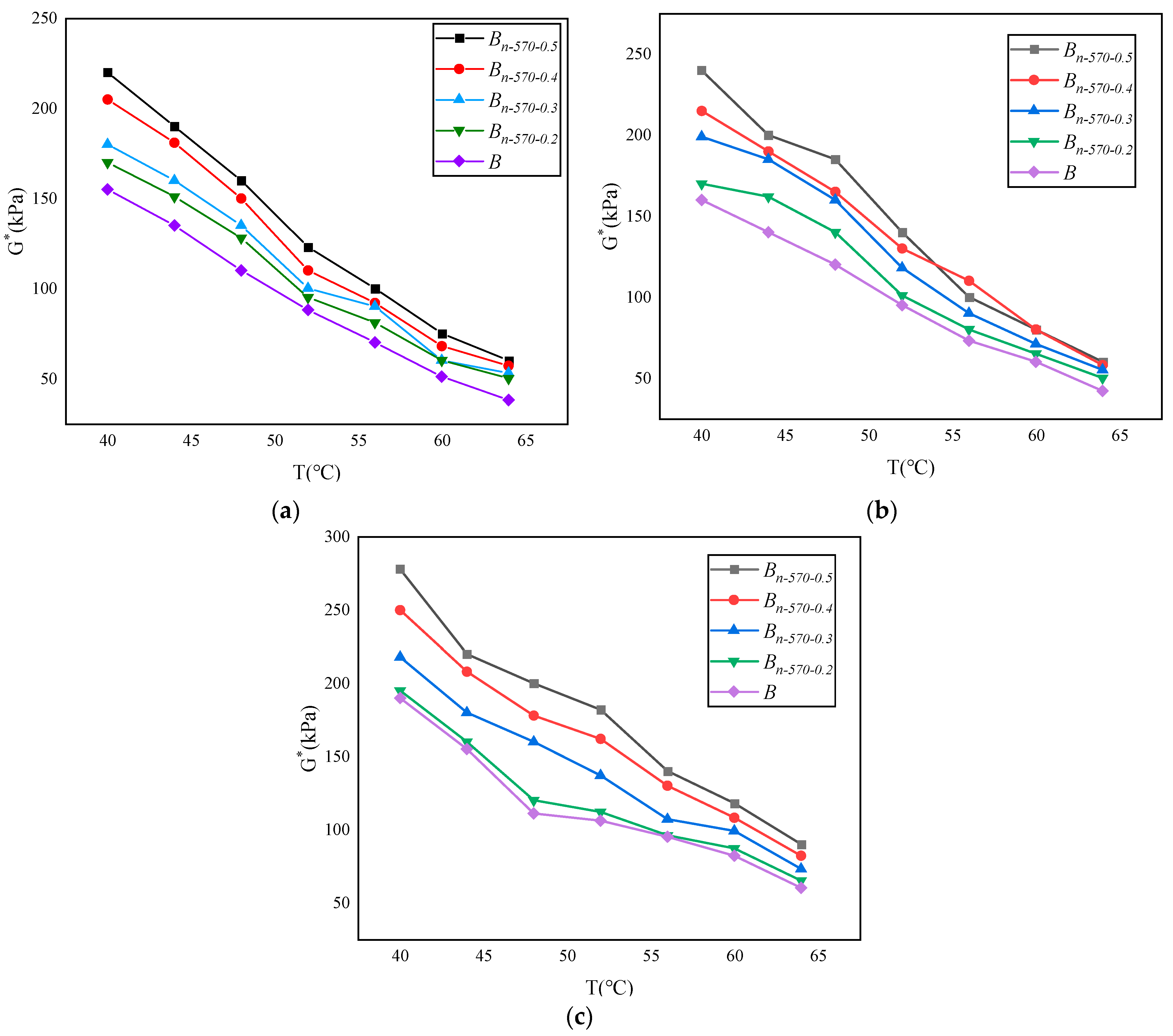
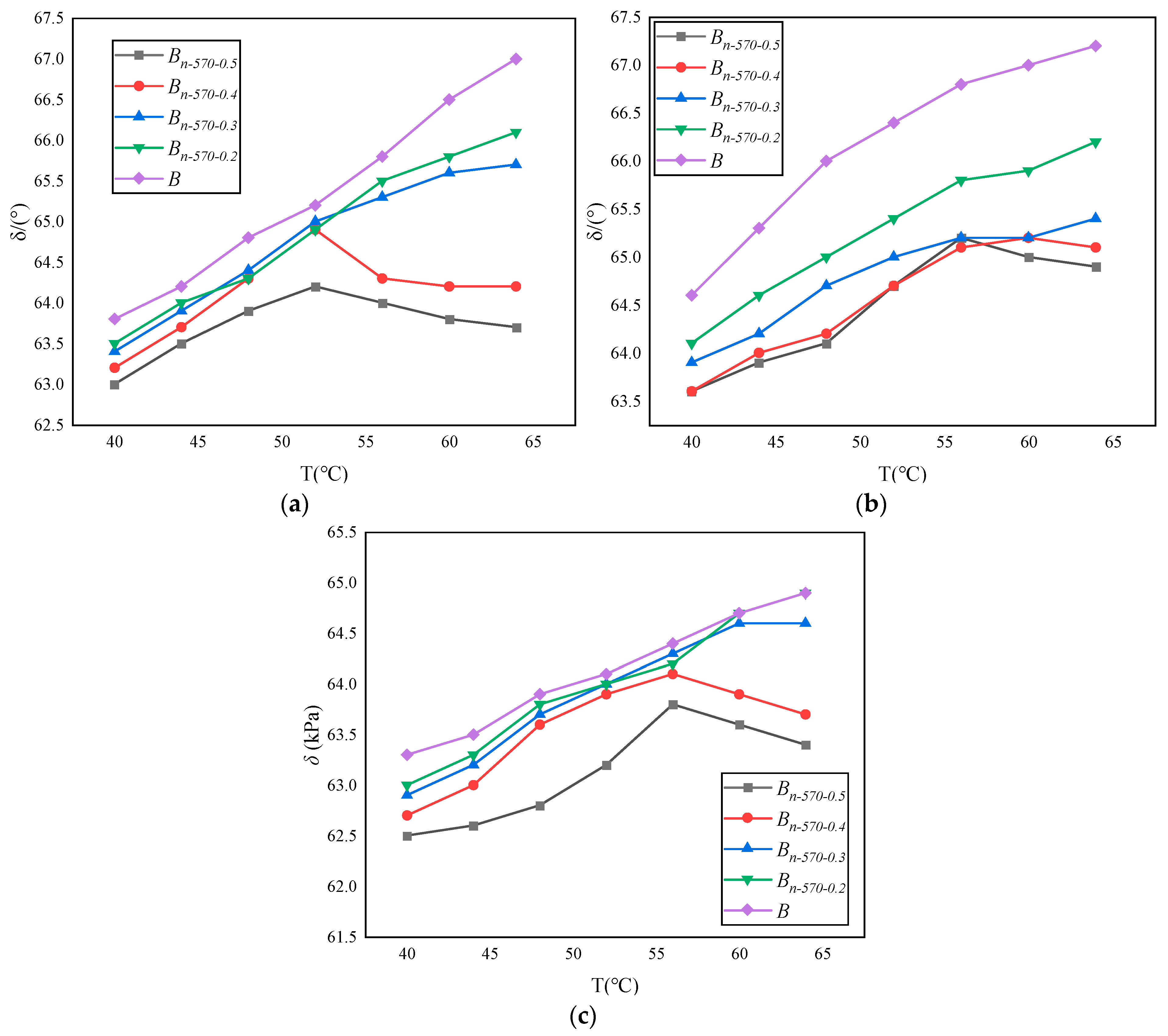
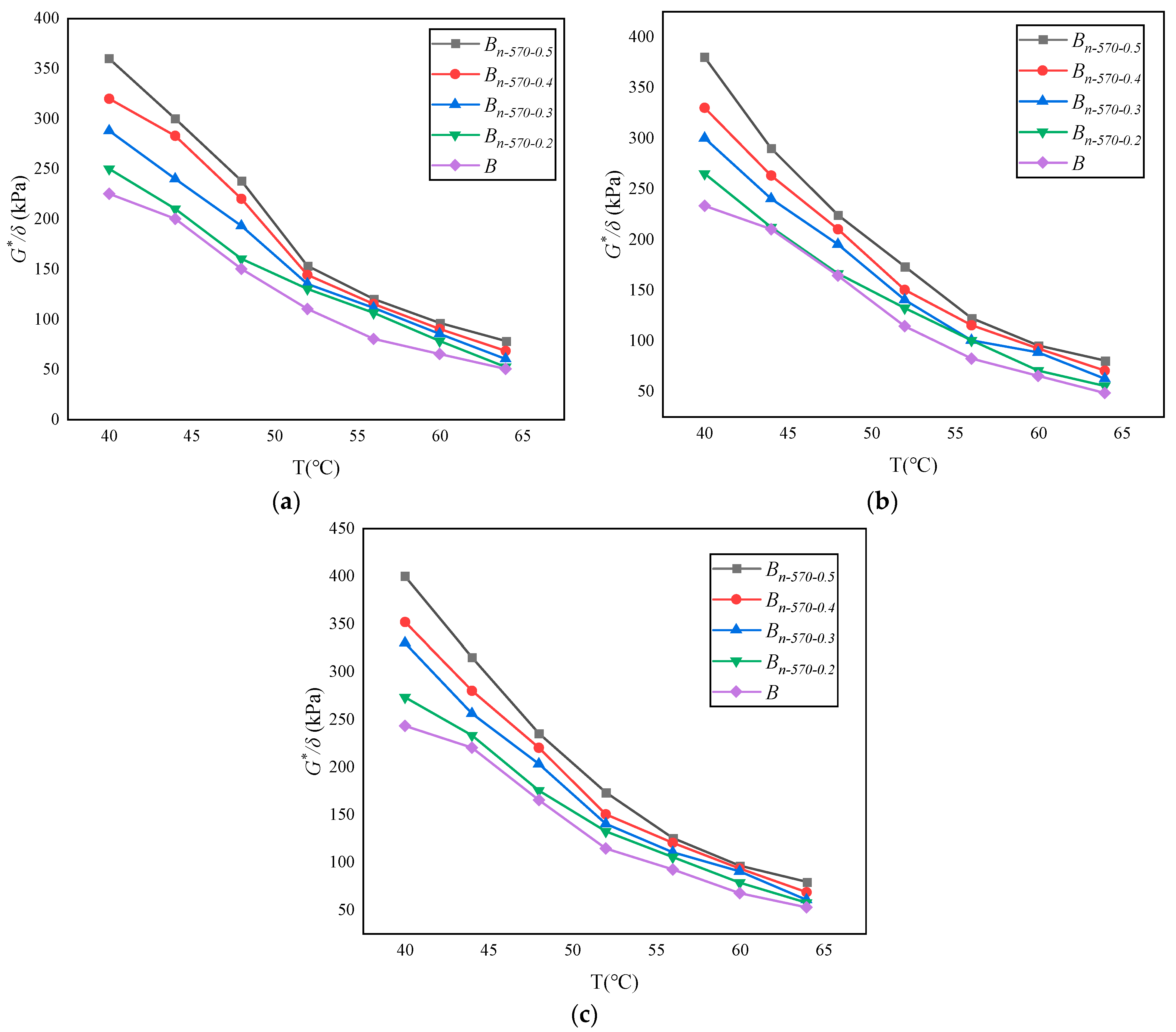
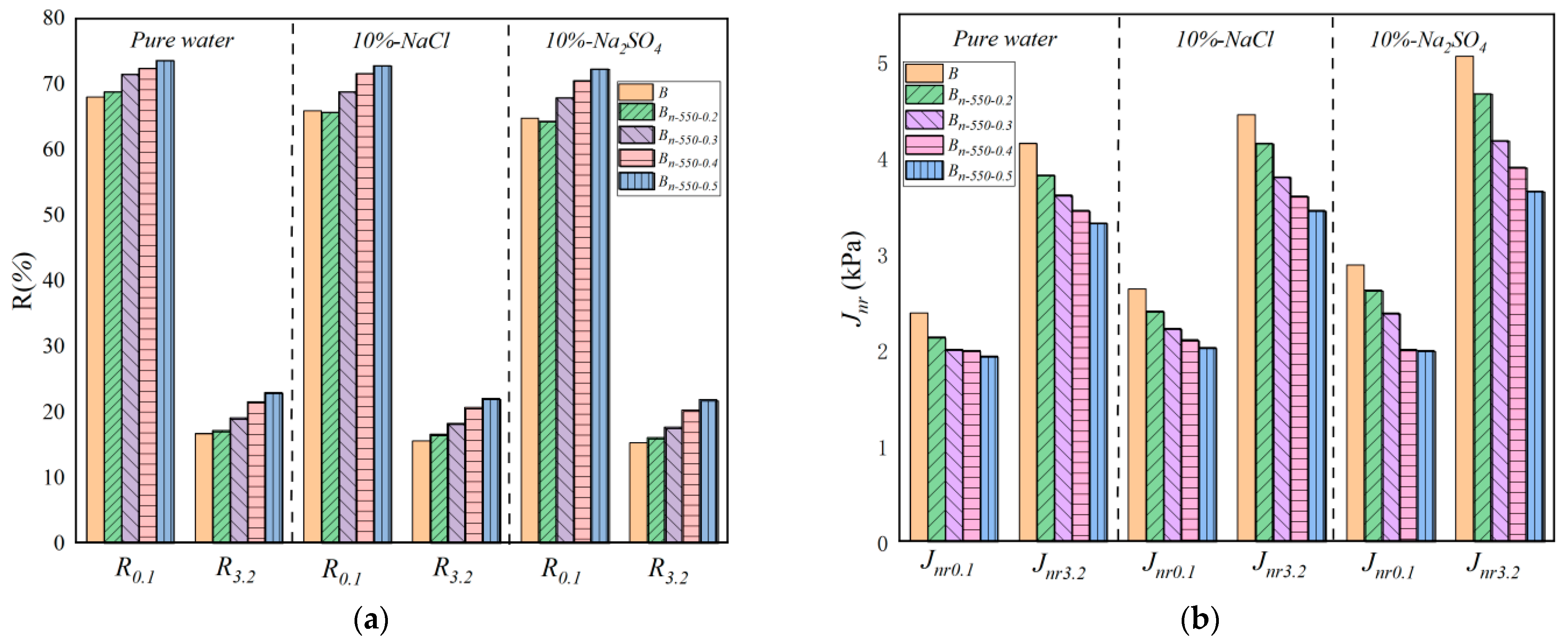


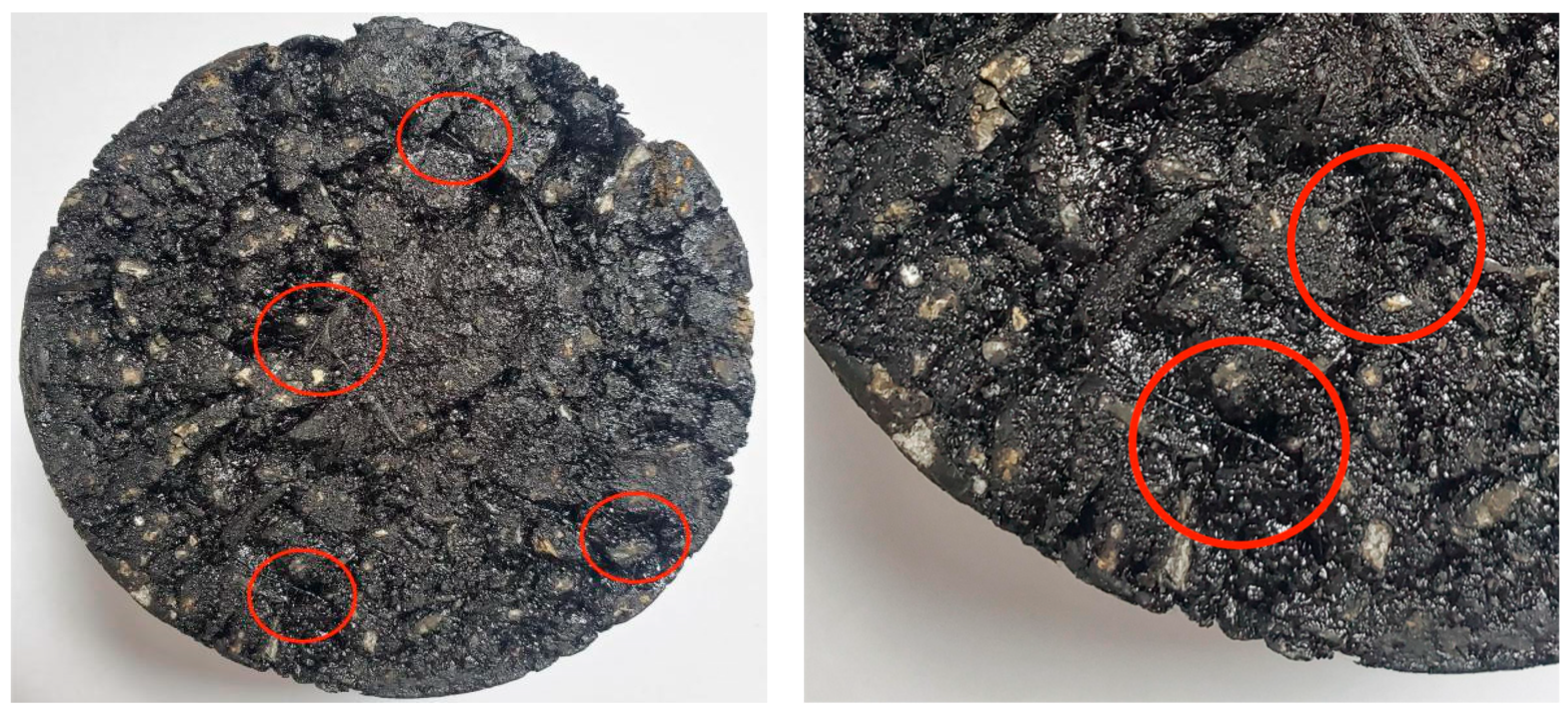
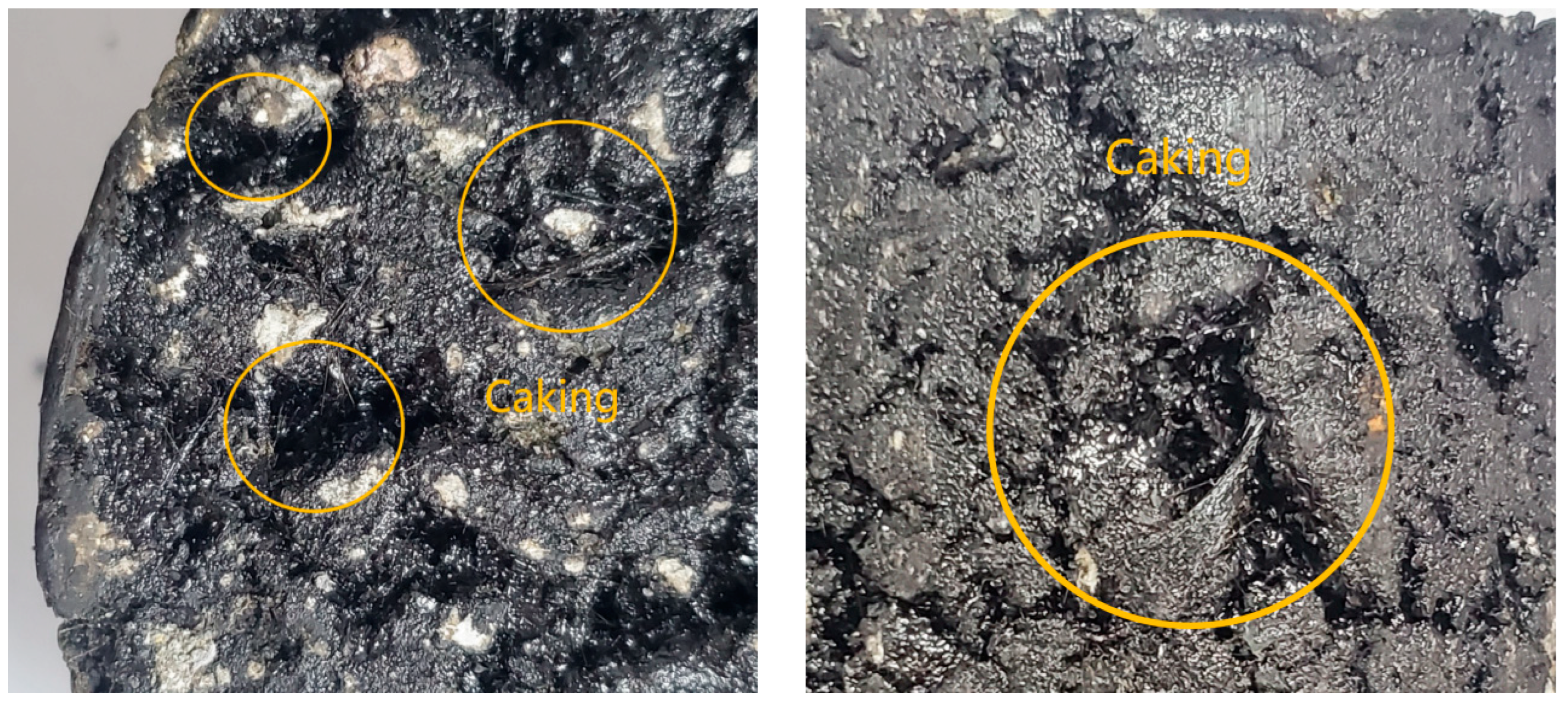
| Tested Property | Unit | Test Value | Standard Value | Standard | |
|---|---|---|---|---|---|
| Penetration index | - | 0.62 | −1.5 ± 1.0 | T0604 | |
| Softening point | °C | 48 | ≥44 | T0606 | |
| Flash point | °C | 285 | ≥260 | T0611 | |
| Dynamic viscosity | 135 °C | Pa·s | 2.5 | ≤3 | T0739 |
| Penetration | 15 °C, 100 g, 5 s | 0.1 mm | 44 | - | T0604 |
| 25 °C, 100 g, 5 s | 85 | 80–100 | |||
| 30 °C, 100 g, 5 s | 162 | - | |||
| Ductility | 10 °C, 5 cm/min | cm | 29 | ≥20 | T0605 |
| 15 °C, 5 cm/min | cm | >170 | ≥100 | ||
| After RTFOT | Quality loss | % | 0.09 | ≤1 | T0610 |
| Residual ductility (5 °C) | cm | 70.1 | ≥65 | ||
| Residual ductility (15 °C) | cm | 16.9 | ≥15 | ||
| Penetration ratio (25 °C) | % | 66.4 | ≥57 | ||
| Tested Property | Unit | Test Value | Standard Value | Standard | |
|---|---|---|---|---|---|
| Apparent density | g/cm3 | 2.75 | ≥2.5 | T0352 | |
| Water content | % | 0.2 | ≤1 | T0332 | |
| Hydrophilic coefficient | - | 3 | <1 | T0353 | |
| Particle size | <0.6 mm | % | 99.7 | 100 | T0351 |
| <0.3 mm | % | 99.5 | - | ||
| <0.15 mm | % | 99.2 | 90–100 | ||
| <0.075 mm | % | 88.1 | 75–100 | ||
| Tested Property | Diameter/μm | Length/mm | Water Content/% | Oil Absorption Rate | Heat Resistance (210 °C, 2 h)/% | Melting Point/°C | PH | Ash Content | Tensile Strength/MPa |
|---|---|---|---|---|---|---|---|---|---|
| Bagasse fiber | 300 | 4–6 | 4.5 | 7.4 | 3.8 | 176 | 6.9 | 18 | 172 |
| Standard | - | ≤6 | <5 | ≥5 | ≤6 (no combustion) | 4.2 | 6.5–8.5 | 18 ± 5 | - |
| Ingredients | NaCl | Water | K | Mg, Ca | Water Insoluble | Density (g/cm3) | Solubility/g | Dry Weight Loss |
|---|---|---|---|---|---|---|---|---|
| Percentage | ≥99.5% | <0.5% | ≤0.02 | 0.01 | ≤0.05 | 2.189 | 35 | 0.5% |
| Ingredients | Na2SO4 | Cl | K, Ca, Fe | Water Insoluble | Density (g/cm3) | Solubility/g (20 °C) | Scorch Weightlessness |
|---|---|---|---|---|---|---|---|
| Percentage | ≥99.5% | ≤0.1% | ≤0.2% | ≤0.05 | 2.702 | 20 | 0.2% |
| Name | Appearance | Average Particle Size | Purity | Density (g/cm3) | Specific Surface Area (m2/g) | PH | Drying Weight Loss (%) | Scorch Weight Loss (%) | Crystalline |
|---|---|---|---|---|---|---|---|---|---|
| TiO2 | White powder | 20 nm | 99.99 | 3.8/4.2 | 68–90 | 6–8 | 0.5 | 1.0 | De-titania/rutile |
| Name | Chemical Formula | Boiling Point (760 mmHg)/°C | Density (ρ20), g/cm3 | Flash Point/°C | Molecular Weight | Content |
|---|---|---|---|---|---|---|
| KH550 | C9H23NO3Si | 217 | 0.946 | 104.7 | 221.37 | ≥97 |
| KH570 | C10H20O5Si | 255 | 1.055 | 88 | 248 | ≥97 |
| KH590 | C8H22N2O2Si | 256 | 0.965 | 93 | 206.36 | ≥95 |
| Time Asphalt Samples | B | Bn-570-0.2 | Bn-570-0.3 | Bn-570-0.4 | Bn-570-0.5 | |
|---|---|---|---|---|---|---|
| Softening point difference (°C) | 3 h | 1.6 | 1.3 | 1.2 | 1.1 | 1.1 |
| 6 h | 4.6 | 3.7 | 2.4 | 1.9 | 1.8 | |
| 12 h | 5.6 | 4.5 | 3.3 | 2.4 | 2.2 | |
| 24 h | 5.8 | 4.6 | 3.3 | 2.5 | 2.2 |
| Solution | Sample | Nf-450 | Nf-750 | Nf-1050 | Fatigue Model | R2 |
|---|---|---|---|---|---|---|
| Water | B | 10,671 | 2830 | 1488 | 4.5 × 1010 (ε)−2.496 | 0.9993 |
| Bn-570-0.2 | 14,030 | 3449 | 2784 | 2.85 × 1010 (ε)−2.738 | 0.9999 | |
| Bn-570-0.3 | 36,942 | 8030 | 3169 | 2.67 × 1012 (ε)−2.962 | 0.9998 | |
| Bn-570-0.4 | 47,299 | 10,559 | 3519 | 3.60 × 1012 (ε)−2.970 | 0.9986 | |
| Bn-570-0.5 | 54,971 | 23,112 | 3841 | 2.39 × 1010 (ε)−2.125 | 0.9284 | |
| NaCl | B | 9028 | 2445 | 1272 | 3.14 × 1010 (ε)−2.465 | 0.9978 |
| Bn-570-0.2 | 11,996 | 2904 | 2363 | 2.80 × 1010 (ε)−2.401 | 0.9657 | |
| Bn-570-0.3 | 32,077 | 7002 | 2678 | 2.37 × 1012 (ε)−2.966 | 0.9997 | |
| Bn-570-0.4 | 41,435 | 9186 | 3144 | 3.23 × 1012 (ε)−2.974 | 0.9998 | |
| Bn-570-0.5 | 46,973 | 19,899 | 3380 | 1.87 × 1010 (ε)−2.109 | 0.9637 | |
| Na2SO4 | B | 8576 | 2330 | 1196 | 3.01 × 1010 (ε)−2.467 | 0.9991 |
| Bn-570-0.2 | 11,280 | 2748 | 2221 | 2.52 × 1010 (ε)−2.394 | 0.9665 | |
| Bn-570-0.3 | 30,184 | 6665 | 2501 | 2.05 × 1012 (ε)−3.012 | 1 | |
| Bn-570-0.4 | 38,907 | 8686 | 2975 | 2.81 × 1012 (ε)−3.04 | 0.9998 | |
| Bn-570-0.5 | 45,094 | 18,910 | 3220 | 1.96 × 1010 (ε)−2.709 | 0.9303 |
| Erosion Environment | Surface Tension | WSpread | WEr-strip | WCo-strip |
|---|---|---|---|---|
| Water | 72.80 | 79.00 | −2.45 | 76.55 |
| 10%NaCl | 75.93 | 78.84 | −3.51 | 75.33 |
| 10%Na2SO4 | 76.12 | 81.95 | −8.30 | 73.65 |
Disclaimer/Publisher’s Note: The statements, opinions and data contained in all publications are solely those of the individual author(s) and contributor(s) and not of MDPI and/or the editor(s). MDPI and/or the editor(s) disclaim responsibility for any injury to people or property resulting from any ideas, methods, instructions or products referred to in the content. |
© 2023 by the authors. Licensee MDPI, Basel, Switzerland. This article is an open access article distributed under the terms and conditions of the Creative Commons Attribution (CC BY) license (https://creativecommons.org/licenses/by/4.0/).
Share and Cite
Xie, Z.; Tang, L.; Tao, M.; Yang, F.; Zhong, Q. The Properties of Modified Bagasse Fiber/Nano-TiO2 Composite Asphalt in a High-Temperature and High-Humidity Salt Environment. Materials 2023, 16, 5996. https://doi.org/10.3390/ma16175996
Xie Z, Tang L, Tao M, Yang F, Zhong Q. The Properties of Modified Bagasse Fiber/Nano-TiO2 Composite Asphalt in a High-Temperature and High-Humidity Salt Environment. Materials. 2023; 16(17):5996. https://doi.org/10.3390/ma16175996
Chicago/Turabian StyleXie, Zhenxiang, Liansheng Tang, Mengru Tao, Fangjian Yang, and Qilin Zhong. 2023. "The Properties of Modified Bagasse Fiber/Nano-TiO2 Composite Asphalt in a High-Temperature and High-Humidity Salt Environment" Materials 16, no. 17: 5996. https://doi.org/10.3390/ma16175996




